|
< Earlier Kibitzing · PAGE 2 OF 2 ·
Later Kibitzing> |
| Aug-26-17 | | ChessHigherCat: <actinia> Well I generally just learned by playing and only read an occasional chess article in the NY Times, so I was never very good at any kind of notation (like a jazz musician versus a classical musician), so of course it's maddening to switch from one to the other (like speaking Spanish and Portuguese on the same day). I only started using algebraic notation a year ago when I started contributing to this website, but I've made a lot of progress believe it or not (I was even worse before!). Usually I play out my lines on WinBoard now so I can cut and paste the notation, but today when I cut and paste the moves into it, it kept saying "Illegal move: 2. Qa4!" for some mysterious reason so I had to do it the hard way. Anyway, thanks for showing some understanding. Usually people react by saying "You seem to be switching the colors and sides" like it's some kind of psychedelic "through the looking glass" experience instead of attributing to the difference in notation. |
|
| Aug-26-17 | | malt: <ChessHigherCat> Its true, about people do respond to your comments that have mistakes in the notation. |
|
| Aug-26-17 | | actinia: <ChessHigherCat> and <malt>, we can go one step further. I downloaded some 'Inside Chess' articles in *.pdf format from about 20 years ago yesterday and there was one diagram for every ten or so moves, or every five or so moves if the game got very, very interesting. It seems archaic that we used to study chess that way, considering now we can play through almost any game, move by move, in almost any browser and any format. Descriptive notation, such as '1. ... P-K4', is probably mind-boggling and misunderstood by today's players, and it is a wonder it was in use for so long. Not to mention that we used to have to sit down with a physical board and pieces to play over such games, or sometimes we entertained the notion that we could play over such games mentally from diagram to diagram if we were feeling lazy :) |
|
| Aug-26-17 | | WorstPlayerEver: 34. d5 tookz me a glimpse to spot.
Why? Because it's one of those 'click moves.'
Puts pressure on both sides of the board: pawn c6 and Kg7 Must have played through the game once though; it's a Giri game! |
|
| Aug-26-17 | | malt: <actinia> I gave chess up at school, I was shown the moves only, then thrown to the wolves. The game was never explained, I thought it was posh draughts, and soon gave it up. |
|
| Aug-26-17 | | WorstPlayerEver: Position after: 35. Rc1
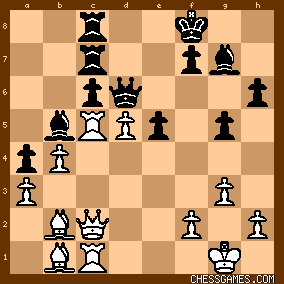
click for larger view |
|
| Aug-26-17 | | actinia: <malt> the same thing happened to me, at a very young age. they were just trying to lord it over |
|
| Aug-26-17 | | actinia: well, like 8-9 years old. if that is a very young age |
|
| Aug-26-17 | | morfishine: Seen this one, remarkable continuation by Kramnik |
|
| Aug-26-17 | | malt: Continuation from earlier post
<34.d5 B:b2>
came up with
34.d5 e5 35.Qf5 Re8
for move 36.? Rec1 or Be4 |
|
| Aug-26-17 | | Altairvega: 34. d5 Bxb2 35 Qxb2 if 35..exd5 36 Qh8 mate If 35 ..Qd8 36 Qh8 Ke7 37Qxh6 etc |
|
| Aug-26-17 | | DonPepe: Very difficult to see from 34.d5 that 46.Bd5 |
|
| Aug-26-17 | | RandomVisitor: After 32.Qc2
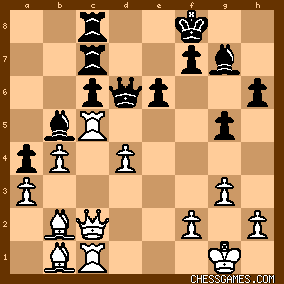
click for larger viewStockfish_17081107_x64_modern: <2.7 hours computer time, 8 cores> <+0.41/58 32...Bxd4 33.Re1 Bxc5> 34.bxc5 Qe7 35.Qh7 Ke8 36.Qxh6 Qxc5 37.Ba2 Qf5 38.Qh8+ Ke7 39.Qg7 Ke8 40.Be5 Qg6 41.Qxg6 fxg6 42.Bxc7 Rxc7 43.Rxe6+ Re7 44.Rxe7+ Kxe7 45.Bb1 Kf7 46.Kg2 c5 47.f3 Be8 48.Kf2 Bc6 49.Bc2 Kf6 50.Ke3 Bb5 51.Be4 Be8 52.Kd3 Bb5+ 53.Kc3 Kf7 54.Kb2 Bd7 55.Kc1 Be8 56.Kc2 Ke6 57.Kc3 Kd6 58.Kc4 Bf7+ 59.Kd3 Be8 60.Kc3 Ke5 61.Kc4 Kd6 62.Kd3 Ke6 63.Ke2 Kf6 64.Kd2 Bb5 65.Bc2 Be8 66.Kc3 Bb5 67.Bd3 Bxd3 68.Kxd3 Ke7 69.Kc4 Kd6 |
|
| Aug-26-17 | | botvinnik64: What great maneuvering by Kramnik. He plays a tactical move (d5) then proceeds to squeeze Black who is bereft of counter play, then finishes him off w another tactical blow (QxR). Just a beautiful conclusion. I could look at this for hours. |
|
| Aug-26-17 | | RandomVisitor: After 33...Kf8
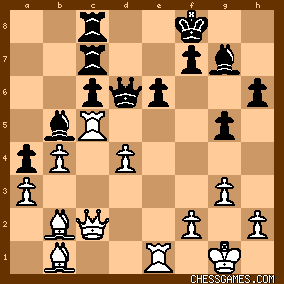
click for larger viewStockfish_17081107_x64_modern: <2.7 hours computer time, 8 cores> +5.57/46 34.d5 e5 35.<Qh7> Re8 36.Rec1 Rb8 37.Be4 cxd5 38.Rxc7 dxe4 39.Qxe4 Rd8 40.R7c5 Bd3 41.Qe3 Re8 42.Rc8 Ba6 43.Rxe8+ Kxe8 44.Qc5 Qxc5 45.Rxc5 f6 46.Ra5 Bd3 47.b5 Kd7 48.Ra7+ Ke6 49.Rxg7 Bxb5 50.f4 exf4 51.Rg6 fxg3 52.Rxf6+ Kd5 53.hxg3 h5 54.Rf5+ Kc6 55.Rxg5 Be2 56.Re5 Bd1 57.Bd4 Kb7 58.Kf2 Kc6 59.Rc5+ Kd7 60.Ra5 Kc6 61.Re5 Kd7 62.Rg5 Bg4 63.Rd5+ Kc6 64.Rc5+ Kb7 65.Ra5 Bd1 66.Ke3 |
|
| Aug-26-17 | | patzer2: For today's Saturday puzzle solution, White wins with the clearance tactic 34. d5! ± (+3.67 @ 33 depth, Stockfish 8) which offers a poisoned pawn to open up lines of attack against Black's weak King position. If 34...cxd5, White wins decisive material with the in-between move (a.k.a. zwischenzug) sequence 35. Bxg2+ Kxg2 36. Qh7+ Kf8 37. Qxh6+ Ke7 38. Rxb5+ +- (+9.28 @ 28 depth, Stockfish 8.) If 34...exd5?, White has a quick mate-in-three with 35. Bxg7+ Kxg7 36. Qh7+ Kf6 (36...Kf8 37. Qh8#) 37. Qxh6#. If 34...Bxb2, White gets a winning attack against the weak King position after 35. Qxb2 +- (+4.22 @ 30 depth, Stockfish 8.) Black's best defense is 34. d5! e5, but after 35. Rc1 Bf6 White wins with any number of 36th move choices, including the game move 36. Qf5 +- (+3.24 @ 31 depth, Stockfish 8) or the computer first choice 36. Qc3 Rb8 37. Bf5 +- (+3.93 @ 32 depth, Stockfish 8.) P.S.: For a Black improvement, instead of 32...Ke7? allowing 33. Re1 Rd8 34. d5 +- (+1.85 @ 28 depth, Stockfish 8,) 32...Bxe4 33. Re1! ⩲ to = (+0.33 @ 32 depth, Stockfish 8) holds for Black with only a slight disadvantage. After the computer line 32...Bxd4 33.Re1! ⩲ (+ 0.33 @ 32 depth, Stockfish 8) 33...Bxc5 34.bxc5 Qe7 35.Qh7 Ke8 36.Qxh6 Qxc5 37.Ba2 Qf5 38.Qh8+ Kd7 39.Qd4+ Ke8 40.Bb1 Qf3 41.Qg7 Bc4 42.Be4 Qh5 43.Be5 Bd5 44.Bxc7 Rxc7 45.Qd4 Bxe4 46.Qxe4 c5 47.Qxa4+ Ke7 48.Qc4 Qh8 49.Rd1 Qe5 50.a4 Rd7 51.Rc1 Rd4 52.Qxc5+ Qxc5 53.Rxc5 Rxa4 54.Rxg5 Ra1+ 55.Kg2 f5 56.Rg8 Ra2 57.h3 ⩲ to ± (+0.68 @ 43 depth, Stockfish 8,) Black is down a pawn in a Rook and pawn ending but still has good drawing chances. Earlier, instead of 25...h6 26. Qf4 ⩲ (+0.27 @ 32 depth, Stockfish 8), Black appears to improve with the computer first choice 25...Qd7 26. Qe3 = (0.13 @ 36 depth, Stockfish 8.) |
|
| Aug-26-17 | | ChessHigherCat: <malt: <ChessHigherCat> Its true, about people do respond to your comments that have mistakes in the notation.> It's fine for people to point out errors in my notation, in fact I appreciate it, but what's less admirable is that people respond almost exclusively to my posts with errors for the joy of one-upmanship. I have at least 25 pending questions with perfect notation that nobody deigns to answer, especially if it's something they didn't notice themselves :-) |
|
| Aug-26-17 | | morfishine: The point of the POTD is to solve it without a computer or engine ***** |
|
| Aug-26-17 | | Marmot PFL: Would play 34 d5 to trade the DSBs and I don't think black can allow this without fatally weakening his king. After 34...e5 white is much better with pressure on c-file but I don't see a win. Seems like white still has a lot of work to do. |
|
Aug-26-17
 | | Jimfromprovidence: 42...e4!? might be a saving move for black.

click for larger view It sets up checking moves for the black queen at d1 and f3, so if white still plays 43 R1c7 black has 43...Qd1+ 44 Kg2 Qf3+, etc. 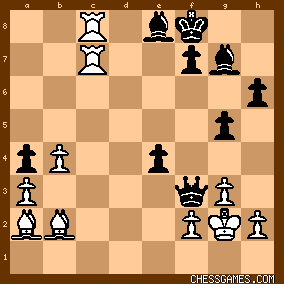
click for larger view |
|
| Aug-26-17 | | SpamIAm: Fist bump to <morfishine>. |
|
| Aug-26-17 | | agb2002: Black threatens Bxd4.
The only idea I found was 34.d5:
A) 34... cxd5 35.Bxg7+ Kxg7 36.Qh7+ Kf6(8) 37.Qxh6+ and 38.Rxb5 + - [B]. B) 34... exd5 35.Bxg7+ Kxg7 36.Qh7+ and mate next. C) 34... Bxb2 35.Qxb2
C.1) 35... cxd5 36.Rxb5 + - [B vs p].
C.2) 35... exd5 36.Qh8#.
C.3) 35... Ke7 36.dxe6 fxe6 37.Qg7+ followed by 38.Qxh6 wins a pawn at least. C.4) 35... Ke8 36.dxe6 fxe6 37.Bg6+ followed by 38.Qg7+ or 38.Qh8+ and 39.Qxh6 as above. C.5) 35... Kg8 36.dxe6 fxe6 37.Qf6 wins a pawn at least. |
|
| Aug-26-17 | | Tiggler: <Jimfromprovidence: 42...e4!? might be a saving move for black.> Yes, I think that draws. But white's 40.Ba3 was a mistake:
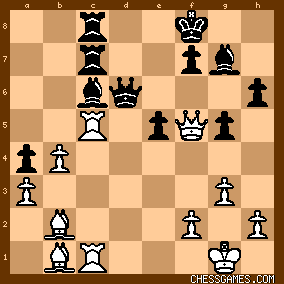
click for larger view 40.Qd3 was correct. |
|
Aug-26-17
 | | Jimfromprovidence: <Tiggler>... <But white's 40.Ba3 was a mistake: 40.Qd3 was correct.> So you are saying that white had the game in hand since 34 d5 but had already let black back in with 40 Ba3. Then black could have stayed equalized with 42...e4 but gave it away with 42...Qd2. Ok. Makes sense to me. |
|
| Aug-26-17 | | Altairvega: Im pround finding the first move 34. d5
Of course I consifered the case black declines the exchange of the bishops. To 34..e5 I would answer 35, Qf5 to attack e5 If 35,,Re8 36, f4 and so on |
|
 |
|
< Earlier Kibitzing · PAGE 2 OF 2 ·
Later Kibitzing> |





